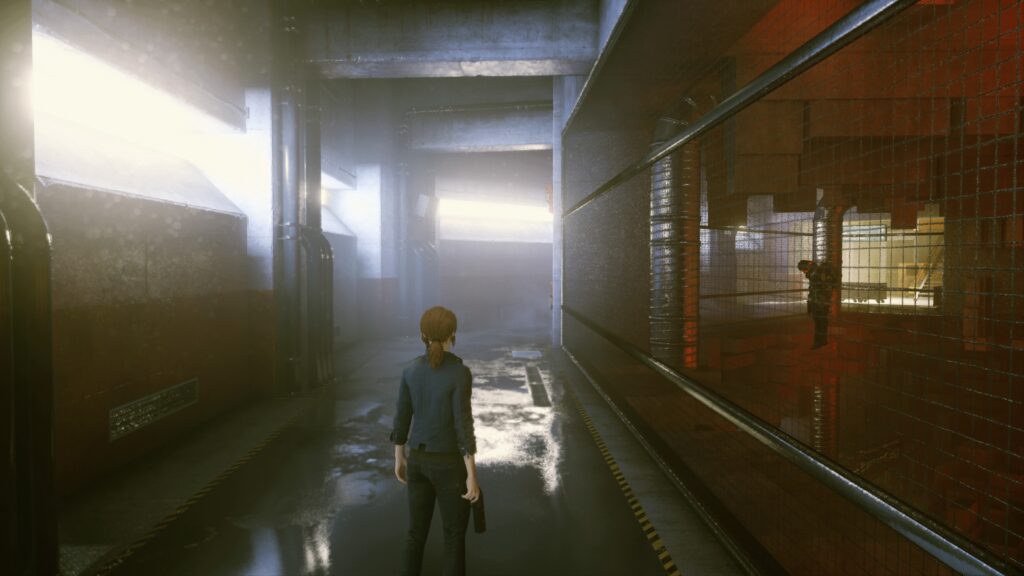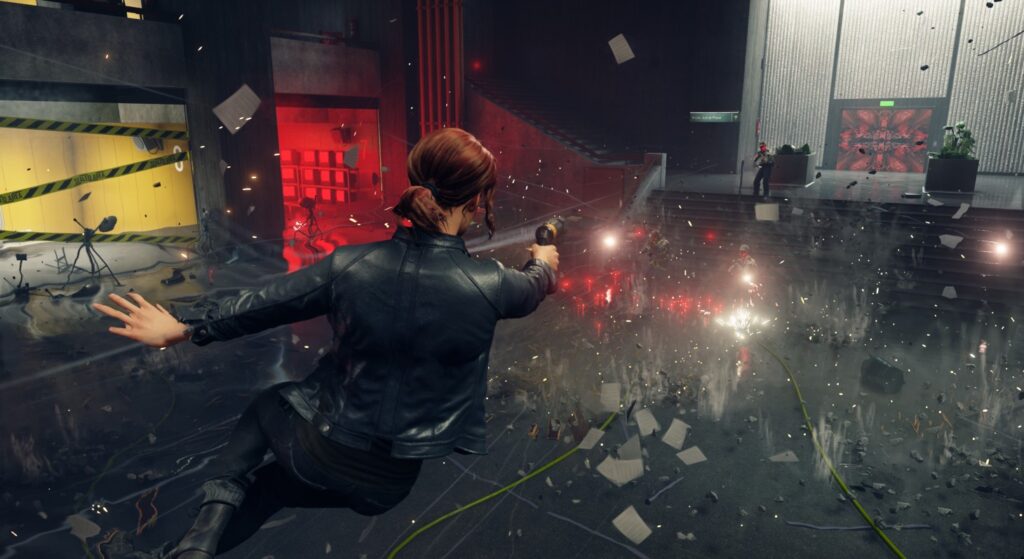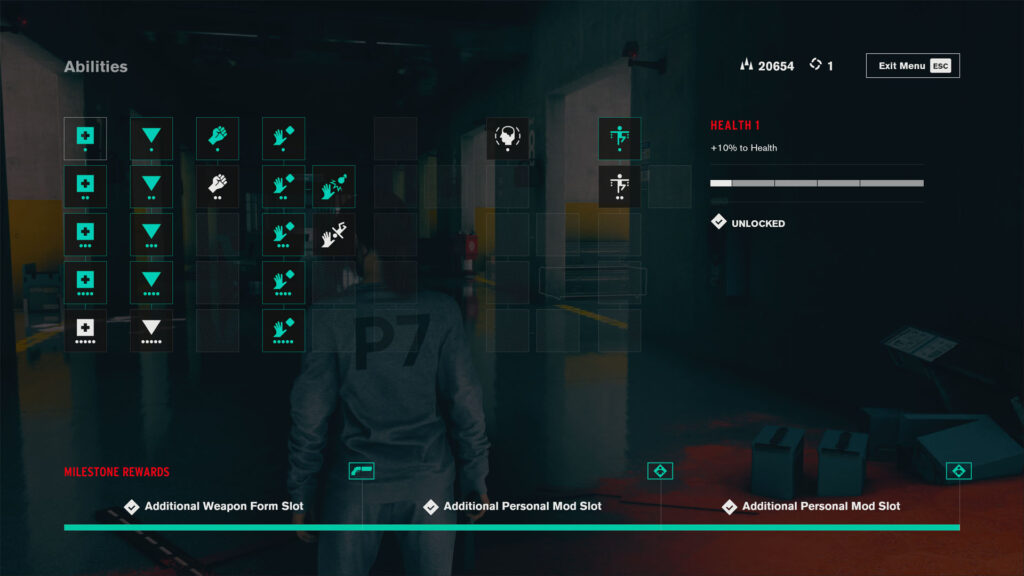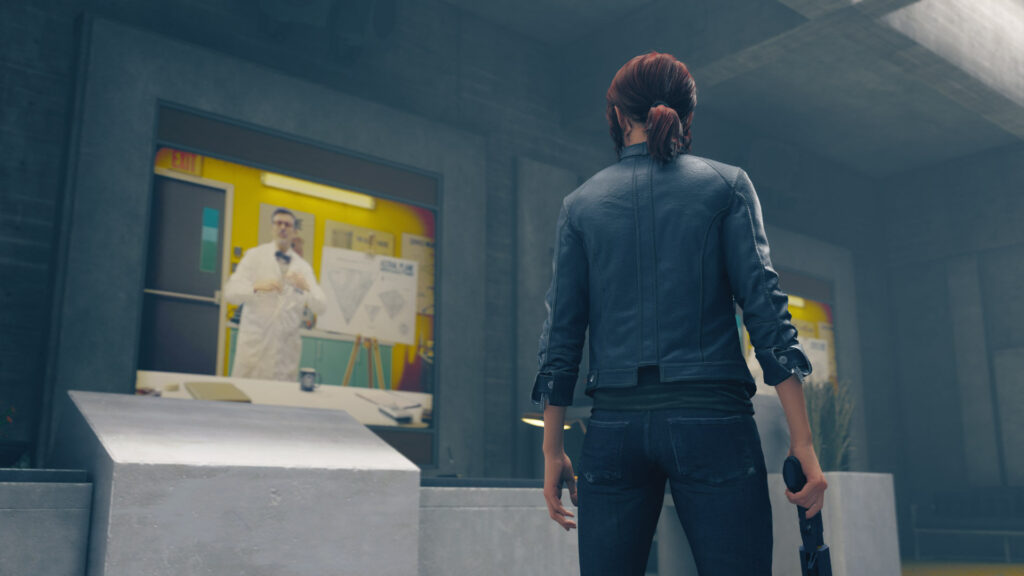Control is an impressive blend of art and technology. Its chaotic firefights with floating particles, bizarre clouds, lighting effects, destructible environments, and physics-focused abilities are simply stunning, a proof of how far the technology has come since the day of good-old pixelated graphics. The impressive details on the most mundane objects, their materials, the clever mixture of reddish fog, alien-like structures, darkened halls, and bright lights make the game also a beauty to behold, a piece of art even.
Video games, however, are more than just that. It’s a big positive if it pleases the eye and experiments with the highest form of technology, but far more important than that is the fact that the video game is an enjoyable experience. Control does that too, but to a lesser degree.

The crazy things
It’s hard to qualify Control in general. It’s a mixture of traditional third-person action game with a lot of shooting and some crazy-ass plot that picks real-time elements and turns up a notch in the absurdity factor to tailor a story of conspiracy and supernatural powers surrounding the protagonist Jesse Faden and the mysterious Federal Bureau of Control (FBC).
The game begins as Jesse Faden enters the building of the agency to search for her brother. At that same time, however, something else is taking over the place, a supernatural hiss echoes through the halls and infects everyone, turning them into dangerous mindless monsters. That’s just scratching the surface though, as the FBC itself is a fictional government agency that hoards supernatural artifacts found across the United States and investigates weird phenomena occurring throughout the country. Jesse finds herself thrown into this agency as she picks a weird-looking gun and is suddenly nominated the director of FBC as chaos takes over the place.
Yes, it sounds crazy, and it is. There are a lot of terms making up the story, such as AWE, O.o.P., FBC, Hiss, and so on. You will learn that everyday ordinary objects are sources of crazy superpowers, like a rubber duck that teleports, a fridge that kills anyone not looking at it, a mirror that takes us to an alternate world, and much much more. It’s completely nuts, and it’s fun to learn more about it as you play.

And it plays well
Although there are a lot of terms and background to the story, Control is far more focused on action, more specifically combat. Well, it’s pretty solid, to say the least.
In a way, Control plays much like a Mass Effect game. It’s a third-person game with shooting and use of powers. Jesse’s basic power allows her to pull things towards her and throw them toward enemies, much like Pull and Throw from Mass Effect. You can hover with the levitate ability to jump-smash targets, you have a super-fast dodge button, you can turn enemies against one another, and so on. Yes, if you’ve played Mass Effect: Andromeda, well, here it is a VERY similar gameplay to that. The only real difference is the fact that Control’s cover system is very secondary and less usable, making combat a much more chaotic thing as you juggle around searching for enemies that may pop from basically everywhere.
When not in combat, you can use these weird abilities to explore the crazy building of the FBC. It’s a stunning place with a lot of detail and secrets to it. You can spend a considerable amount of time just walking around, searching for collectables or trying to reach further places with newly acquired abilities.
The environments are incredibly beautiful too, with cluttered offices where almost every single object can be destroyed, moved, or otherwise interacted with Jesse’s abilities. The Control: Ultimate Edition for the Playstation 5 offers an extra oomph with incredible Ray Tracing reflections that really make the scenery a sight to behold. It’s proper modern video game technology and art, as I’ve mentioned, and exploring this crazy world comes just naturally because of that.

It gets… repetitive
In a time where massive games can take over 100 hours and are bloated with repetitive tasks and grinding, it’s weird how Control, with just under 30 hours, manages to be a microcosm of that experience.
This happens because, like the original Mass Effect it reminds me, it also has very little to offer in terms of renewed experiences. The FBC building is mostly composed of rooms found in modern day offices, like places with desks, bathrooms, halls, conference rooms, maintenance rooms, and so on. After a few hours, you will start to notice them repeating again and again, every place you visit looking strikingly similar to a place you’ve been just a while ago. It gets even worse when the game actually makes you go back to previously visited areas to access a new room or find a new passage to a new part of that area. The magic of exploration of the first hours stalls and when you visit the damn Ocean View Motel yet another time it starts to get even frustrating and annoying.
It doesn’t work in Control’s favor also the fact that the game is far too focused on action. This means that almost every area you enter is full of enemies to kill. While combat is fun, it doesn’t offer enough incentive to fight so many times against the same mob of enemies over and over. The chaos of combat also provides little room for new tactics, as enemies swarm you and you must mostly react to the fight rather than plan ahead. There’s no stealth or surprise element integrated into Control’s gameplay to allow for replayability in those terms. There’s not enough special abilities, custom upgrades, and other tactical choices to make the combat ring for so many hours and so constantly.
After perhaps ten hours or so, the game starts to get far too repetitive. The crazy story plays too little of a role to give you new inspiration too, with most of the interesting bits scattered through collectable notes or shown to you by audio logs or quick montages with some monologue thrown over it. This is frustrating because, when Control actually puts Jesse in cutscenes where she talks and interacts with others, it does a great job. It’s a game that could certainly benefit from more dialogues and introspective cinematics to explore Jesse and the crazy world around her.
It’s also… noisy?
If there’s something in Control that really surprised me, was the fact that, for the first time, a game actually gave me a headache by just playing it. You see, Control offers some pretty impressive graphics, but this also means a LOT of light sources, changes from utter darkness to bright light, tons of movement, and also a soundtrack that is constantly harassed by incessant weird noises. After a few hours playing it, the game simply gives me a headache. I’ve tried to change a lot of options, such as removing blur effects and film grain, changing between Ray Tracing mode and Performance mode, changing camera speed and whatnot, and nothing really worked. From what I could guess, I think it’s a mixture of the constant change between aggressive bright and dark areas mixed with the annoying sounds, but mostly the annoying sounds buzzing and bumbling the entire time throughout the game.

It could work with less
In a way, Control suffers from a problem that has constantly attacked the industry for the past years. Developers seem to search for ways to tuck in as much gameplay time as possible, usually through unnecessarily large open worlds, cluttered places with dozens of quests, or grindy missions. Control is not that, as it’s a considerably “short” game, but it still stretches the experience for too long while offering nothing new after the first couple hours. It’s a game that constantly keeps you fighting the same horde of monsters, with just the occasional unique boss fight, while exploring places that look very similar to one another.
Control also offers a wildly inconsistent difficulty, with most of the game being fairly simple and direct, with mindless puzzles and pushovers fights, but suddenly putting you in a fight where you will die dozens of times or giving you a puzzle/boss fight that makes no sense. Fortunately, Control allows players to bypass these issues with an “Assist Mode” that simply grants you immortality, one-hit-kill shots, and other cheating modes.
It’s still a great game though. The combat is incredible, gameplay is smooth, and it is a superb showcase for modern gaming, with physics-based combat and chaos to every fight that leaves an impressive trail of destruction. It shows what the new hardware of video games is capable of and it combines it with crazy ideas and a beautiful presentation. If the game had perhaps half the size it has, or if it explored its story and gave a refreshment from time to time, it would certainly be a much more interesting experience and still worth the price tag.
Detailed Scores
-
Production
-
Content
-
Polish
-
Concept
-
Fun
